Say Goodbye to Erectile Dysfunction with Physiotherapy Techniques
Are you dealing with erectile dysfunction (ED)? If so, you’re not alone. Fortunately, physiotherapy can be an effective way to treat ED and help you say goodbye to it for good. Physiotherapy helps erectile dysfunction in a variety of ways, such as improving blood flow to the genitals, increasing nerve sensitivity, and strengthening pelvic floor muscles. In this blog post, we’ll explore how physiotherapy can help you get back on track and enjoy a more fulfilling sex life.
What is Erectile Dysfunction?
Erectile dysfunction (ED) is a medical condition characterized by the inability to achieve or maintain an erection firm enough for sexual intercourse. ED affects millions of men worldwide, regardless of age, and can significantly impact their quality of life, relationships, and self-esteem.
ED can manifest in different ways, including difficulty getting or keeping an erection, reduced sexual desire or arousal, or premature ejaculation. It’s crucial to recognize that ED is not a normal part of aging or a personal failure. It’s a treatable medical condition that requires diagnosis and intervention by healthcare professionals.
If you suspect you may have ED, it’s essential to talk to your doctor, who can assess your symptoms, and medical history, and perform tests to identify underlying causes. ED can be a sign of underlying health problems such as cardiovascular disease, diabetes, or hormonal imbalances. Thus, early diagnosis and treatment of ED can improve not only sexual function but overall health outcomes.
In the following sections, we’ll discuss the various causes of ED, traditional treatments, and how physiotherapy can help with this condition.
Causes of erectile dysfunction
Erectile dysfunction can be caused by a variety of factors, both physical and psychological. Physical causes of ED can include vascular problems, hormonal imbalances, nerve damage, and medication side effects. Psychological causes may include anxiety, depression, and stress. In some cases, a combination of physical and psychological factors may be at play.
Fortunately, physiotherapy helps erectile dysfunction by addressing both physical and psychological causes. Physiotherapists use a holistic approach to treating ED, working with patients to identify and address underlying issues that may be contributing to their condition.
By focusing on improving blood flow, reducing tension and stress, and strengthening pelvic floor muscles, physiotherapy can help men regain erectile function. With regular exercise and lifestyle changes, many patients experience significant improvements in their ED symptoms.
Overall, if you are struggling with erectile dysfunction, it is important to seek out help from a trained and experienced physiotherapist. With the right treatment plan and a commitment to making positive changes, you can say goodbye to ED and enjoy a healthier, more fulfilling sex life.
Traditional treatments for ED
For decades, the primary treatment for erectile dysfunction has been oral medications such as Viagra and Cialis. These medications work by increasing blood flow to the penis, making it easier to achieve and maintain an erection.
However, these drugs are not without their drawbacks. They can cause side effects such as headaches, nausea, and flushing. In addition, they are not effective for all men and may not work in cases where the root cause of ED is related to psychological factors.
Another traditional treatment for ED is penile injections. These injections are typically made with medications like alprostadil, which is injected directly into the penis to help stimulate an erection. This treatment is effective for many men, but it can be uncomfortable and may cause pain or bruising at the injection site.
For those who prefer a less invasive approach, there are also penile implants available. These devices are surgically inserted into the penis and allow the user to achieve an erection when desired. However, this is a significant surgical procedure with risks of infection, complications, and permanent loss of sensation.
While these treatments can be effective for some men, they may not be the best option for everyone. Physiotherapy offers a non-invasive, holistic approach to treating ED that can help improve sexual function without the need for medications or surgery.
How can physiotherapy help with ED?
While traditional treatments for ED such as medications, surgery, and vacuum pumps can be effective, they can also come with side effects or be invasive. Physiotherapy, on the other hand, offers a non-invasive approach that can help men restore erectile function.
Pelvic Floor Muscle Exercises:
Pelvic floor muscles play an important role in erectile function. Weak pelvic floor muscles can contribute to ED, as they support the penis and aid in achieving and maintaining an erection. Pelvic floor muscle exercises can help to strengthen these muscles and improve blood flow to the area. A physiotherapist can teach men how to properly perform pelvic floor muscle exercises.
Biofeedback is a technique used to help patients learn how to control their bodily functions such as heart rate or muscle tension. In the context of ED treatment, biofeedback can be used to teach men how to control their pelvic floor muscles and improve erectile function. By attaching sensors to the pelvic area, a physiotherapist can monitor muscle activity and provide feedback on the effectiveness of exercises.
Physiotherapists can also provide guidance on lifestyle changes that can help improve ED symptoms. This can include dietary recommendations, weight loss programs, smoking cessation strategies, and stress management techniques.
Choosing a Physiotherapist:
When seeking physiotherapy for ED, it’s important to choose a qualified and experienced practitioner. Look for a physiotherapist with specific experience in treating male sexual health issues and ask for references or patient testimonials.
Many men have successfully restored erectile function through physiotherapy techniques. By strengthening pelvic floor muscles, learning how to control them, and making positive lifestyle changes, men can see improvements in their ED symptoms. Physiotherapy offers a safe and non-invasive approach to treating ED, allowing men to regain confidence and enjoy sexual activity once again.
Pelvic floor muscle exercises for ED
Pelvic floor muscle exercises, also known as Kegels, are a popular and effective method of treating erectile dysfunction. These exercises involve contracting and relaxing the muscles in the pelvic area to improve blood flow and increase muscle strength.
Pelvic floor exercises help to strengthen the muscles that support the bladder, bowel, and penis. When these muscles are strong, they can help to prevent urinary and bowel incontinence, as well as improve erectile function. By improving blood flow to the penis, these exercises can also help to enhance sexual pleasure and increase the chances of achieving and maintaining an erection.
To perform pelvic floor muscle exercises, start by identifying the correct muscles. You can do this by stopping the flow of urine midstream or tightening the muscles that you use to prevent passing gas. Once you have identified the correct muscles, contract them for 5-10 seconds and then relax them for 10-15 seconds. Repeat this cycle 10-15 times in a row, several times a day.
It’s important to note that over-exercising the pelvic floor muscles can actually do more harm than good, so it’s important to follow a proper exercise plan that is tailored to your individual needs. A physiotherapist can help you to design an exercise program that is right for you and monitor your progress to ensure that you are on track to achieving your goals.
Pelvic floor muscle exercises are just one of many techniques that physiotherapists can use to help men overcome erectile dysfunction. With the right guidance and support, many men have successfully regained their sexual function and enjoyed a more fulfilling sex life.
Lifestyle changes for ED
In addition to physiotherapy techniques, making lifestyle changes can also improve erectile dysfunction. Here are some lifestyle changes to consider:
- Exercise regularly: Physical activity helps to improve circulation, which can have a positive effect on ED.
- Maintain a healthy weight: Being overweight or obese can contribute to ED. By losing weight and maintaining a healthy weight, you may be able to improve your symptoms.
- Eat a balanced diet: A healthy diet that includes plenty of fruits, vegetables, whole grains, lean proteins, and healthy fats can improve your overall health, which may have a positive impact on ED.
- Reduce stress: Stress and anxiety can have a negative impact on sexual function. Finding ways to reduce stress, such as through meditation, yoga, or deep breathing exercises, may help to improve ED symptoms.
- Limit alcohol consumption: Drinking alcohol in excess can contribute to ED. Limiting your alcohol intake or avoiding it altogether may help to improve your symptoms.
It’s important to remember that making lifestyle changes may not be enough to treat ED on its own. However, in combination with physiotherapy techniques, they can be an effective way to improve your sexual function and overall health.
When choosing a physiotherapist to work with, be sure to look for someone who has experience in treating ED and who can work with you to develop a comprehensive treatment plan that includes lifestyle changes. By taking a proactive approach to your health, you can say goodbye to ED and enjoy a more fulfilling sex life.
Choosing a physiotherapist for ED treatment
When it comes to treating erectile dysfunction with physiotherapy techniques, choosing the right physiotherapist is crucial. Here are some tips to help you make the right decision:
- Look for experience: Choose a physiotherapist who has experience in treating men with erectile dysfunction. They should have a thorough understanding of the anatomy and physiology of the male genitalia.
- Check their qualifications: Make sure the physiotherapist is qualified and registered with the relevant governing body. Look for additional certifications or training in pelvic floor physiotherapy.
- Check their approach: Every physiotherapist will have their approach to treating erectile dysfunction. Look for one who uses evidence-based techniques, customizes treatment plans, and is patient-centred.
- Check their availability: It’s essential to find a physiotherapist who is available and accessible when you need them. They should also be able to offer remote consultations and online support.
- Look for patient testimonials: Don’t be afraid to ask for patient testimonials or references. It’s essential to hear from other men who have been successfully treated for erectile dysfunction by the physiotherapist.
- Check their fees: Find out about the physiotherapist’s fees and any insurance or funding options available. Choose a physiotherapist who offers transparent and affordable pricing.
In summary, choose a physiotherapist with experience, qualifications, a patient-centered approach, availability, positive testimonials, and transparent fees. With the right physiotherapist, you can overcome erectile dysfunction and improve your sexual function and overall quality of life.












